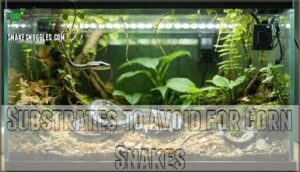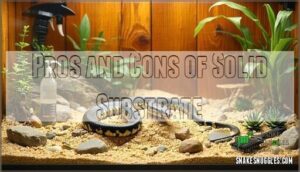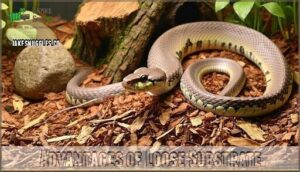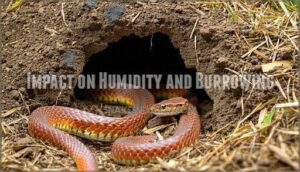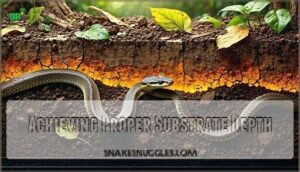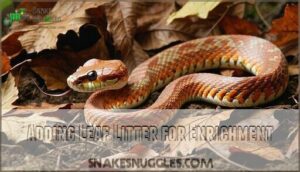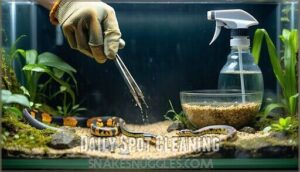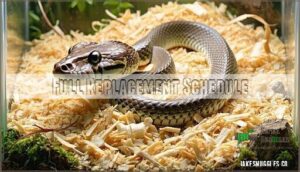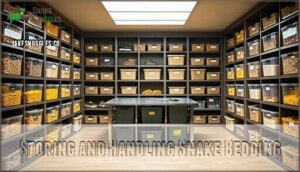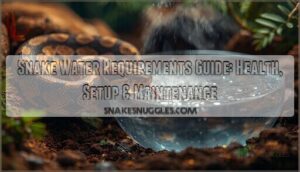This site is supported by our readers. We may earn a commission, at no cost to you, if you purchase through links.

You’ll want bedding that absorbs moisture quickly, maintains 65-75% humidity, and stays dust-free to prevent respiratory issues.
Avoid pine or cedar shavings since aromatic oils cause health problems.
Coconut fiber works well for humidity control and burrowing, while aspen shavings offer a low-dust alternative.
Your snake needs 3-4 inches of substrate depth for proper tunneling.
Budget options like coconut fiber cost $8-15 per bag, though DIY blends can save you money.
The right bedding choice depends on balancing your snake’s biological needs with your maintenance preferences and budget constraints.
Table Of Contents
- Key Takeaways
- Key Factors When Choosing Corn Snake Bedding
- Top Recommended Substrate Types
- Substrates to Avoid for Corn Snakes
- Solid Vs Loose Bedding Options
- Setting Up and Maintaining Bedding
- Tips for DIY and Bioactive Setups
- Storing and Handling Snake Bedding
- Frequently Asked Questions (FAQs)
- What substrate should a corn snake have?
- How deep should corn snake bedding be?
- What is the best bedding for snakes?
- What should I use for snake bedding?
- What is the best bedding for a corn snake?
- What is the best substrate for corn snakes?
- How to choose a corn snake enclosure?
- How often should I Change my corn snake’s bedding?
- Can corn snakes use sand as substrate?
- Are certain substrates better for snake health?
- Conclusion
Key Takeaways
- You’ll need 3-4 inches of loose substrate like coconut fiber or cypress mulch that supports your snake’s natural burrowing instincts while maintaining 65-75% humidity for healthy shedding.
- Avoid pine, cedar, and fir shavings since their aromatic oils cause respiratory problems and liver stress – stick with dust-free options that won’t harm your snake’s health.
- Choose substrates with good absorbency and odor control to prevent bacterial growth and mold formation, which keeps your snake’s environment clean and extends the bedding’s lifespan.
- Budget-conscious options like coconut fiber ($8-15 per bag) or DIY topsoil mixes can save money while providing the same humidity control and burrowing opportunities as premium commercial blends, ensuring healthy shedding.
Key Factors When Choosing Corn Snake Bedding
Selecting the right bedding for your corn snake involves considering several critical factors that directly impact your pet’s health and comfort.
You’ll need to evaluate how well different substrates absorb waste, control odors, maintain proper humidity levels, and support your snake’s natural burrowing instincts.
Absorbency and Odor Control
Proper absorbency prevents waste buildup and eliminates odors that can stress your snake.
Clean bedding means healthy snakes and happy keepers
Quality corn snake bedding should absorb moisture quickly while preventing bacteria growth and mold formation. This maintains a healthier environment and extends substrate lifespan.
- Immediate waste removal keeps your snake’s home fresh and prevents harmful bacteria from multiplying in damp spots
- Mold prevention protects your pet from respiratory issues that can develop in poorly ventilated, moisture-heavy environments
- Extended substrate lifespan saves money by reducing how often you need complete bedding replacements
Humidity Regulation
Substrate moisture directly impacts your snake’s health and comfort. You’ll need bedding that maintains 65-75% humidity for shedding success and respiratory health without creating soggy conditions that promote mold.
A good option is to use coconut fiber bedding for humidity control.
| Humidity Level | Snake Health Impact |
|---|---|
| Too Low (Below 60%) | Poor shedding, dehydration |
| Ideal (65-75%) | Healthy shedding, proper hydration |
| Too High (Above 80%) | Mold growth, respiratory issues |
The best snake bedding holds moisture steadily without becoming waterlogged. Your corn snake bedding choice affects everything from hydration levels to mold prevention in your snake enclosure setup.
Dust and Scent Considerations
When choosing the best snake bedding, you’ll want dust-free options to prevent respiratory irritation and dust allergies.
Aromatic oils from pine or cedar shavings cause scent sensitivity issues.
Look for nontoxic snake bedding without VOCs that could harm your snake’s health.
This reptile substrate guide recommends avoiding heavily scented materials.
Aspen snake bedding works well for those seeking low-dust alternatives.
Burrowing Suitability
Corn snakes are natural diggers who need substrate that supports their burrowing instincts.
Look for loose bedding that holds its shape when damp but won’t collapse tunnels.
Natural snake bedding like coconut fiber bedding and quality soil mixes provide excellent tunnel stability.
Proper substrate depth of 3-4 inches lets your snake create secure hideaways, boosting enrichment value and snake security naturally.
Cost and Availability
Budget-conscious snake keepers face three main cost considerations when selecting affordable snake bedding:
- Budget substrates like coconut fiber cost $8-15 per bag versus premium mixes at $25-40
- Bulk buying from online retailers reduces per-unit costs by 30-50% compared to local pet stores
- DIY cost for homemade substrate blends averages $12-18 for 80 quarts versus $35+ for commercial options
Local availability affects pricing substantially, with rural areas often lacking reptile bedding options.
Top Recommended Substrate Types
Now you’ll find the substrate types that consistently deliver the best results for corn snake health and keeper convenience. These recommendations balance humidity control, burrowing opportunities, and practical maintenance needs.
Zilla Jungle Mix
Zilla Jungle Mix offers a fluffy texture that’s perfect for burrowing while maintaining excellent humidity retention.
This nontoxic snake bedding contains kiln-dried fir wood that’s generally safe for reptiles, though some keepers question fir wood safety.
The natural earthy scent creates a realistic environment that aids snake shedding, and many keeper experiences highlight its effectiveness as both a safe snake substrate and bioactive snake substrate option for corn snake care.
Proper selection helps with snake’s overall well-being, which is a critical aspect of their health.
Substrates to Avoid for Corn Snakes
While many bedding options seem perfect for corn snakes, several common substrates can seriously harm your pet’s health.
You’ll want to avoid pine, cedar, and fir shavings, sand, gravel, bark chips, reptile carpet, and even paper towels for long-term housing, as they can cause significant issues, making avoid them crucial for the snake’s well-being.
Pine, Cedar, and Fir Shavings
While these woods smell nice, they’re toxic trouble for your snake.
Pine, cedar, and fir shavings release aromatic oils that cause respiratory irritation and potential neurological damage through shaving toxicity.
These volatile compounds stress your snake’s liver and lungs.
Safe alternatives like cypress mulch, paper-based snake bedding, or bioactive snake substrates provide humidity control bedding without health risks.
Sand, Gravel, and Bark Chips
Despite seeming harmless, sand, gravel, and bark chips create serious Impaction Risks when your snake accidentally swallows them during feeding.
These materials promote Bacterial Growth due to poor absorbency, while their Abrasive Textures can scratch delicate skin during burrowing.
Ingestion Hazards make them dangerous choices, though they’ve Alternative Uses in terrariums for decoration only.
A good substrate should mimic their natural habitat to best support healthy shedding.
Reptile Carpet and Shelf Liner
Reptile carpet and shelf liner create serious problems for your corn snake’s health.
Carpet harbors bacteria despite regular carpet disinfection efforts, while liner VOCs from non-certified products can harm respiratory systems.
Both options have absorbency issues that lead to waste accumulation and poor odor control bedding performance.
These materials also create burrowing limitations, preventing natural behaviors your snake needs for proper shedding and stress relief.
Paper Towels and Newspaper
You’ll find paper-based snake bedding tempting for quarantine setups, but it falls short for permanent housing.
While these options offer excellent waste visibility and cost effectiveness for short-term use, they can’t support your corn snake’s natural behaviors or maintain proper humidity levels.
- Zero burrowing opportunities – your snake can’t express natural digging instincts
- Constant humidity battles – requires extra misting and monitoring to prevent dehydration
- Messy feeding situations – substrate sticks to prey items and creates cleanup headaches
- Limited odor control bedding capabilities compared to absorbent alternatives
- Frequent replacement needs – daily changes during shedding periods drain your wallet
Paper towels and newspaper work perfectly for hygiene monitoring during quarantine or illness recovery, allowing you to spot health issues quickly.
However, they’re inadequate for long-term snake health bedding needs.
Solid Vs Loose Bedding Options
When choosing bedding for your corn snake, you’ll face a fundamental decision between solid and loose substrate options.
Each type offers distinct advantages and drawbacks that directly affect your snake’s comfort, health, and natural behaviors.
Pros and Cons of Solid Substrate
Solid substrate offers straightforward maintenance and safety benefits, but limits natural behaviors.
You’ll find cleaning solid substrate simple since you can remove and wash sections without disturbing the entire enclosure.
| Aspect | Pros | Cons |
|---|---|---|
| Cleaning | Easy spot cleaning, removable sections | Weekly washing required, staining possible |
| Safety | No impaction risk, dust-free | Poor humidity control, rapid spill cleanup needed |
| Behavior | Eliminates ingestion concerns | Blocks burrowing, reduces enrichment |
| Cost | Low initial expense, reusable | Recurring replacement costs over time |
| Health | Minimal respiratory irritation | Requires extra humidity sources, limits shedding aid |
Paper-based snake bedding and reptile carpet eliminate bacteria buildup when properly maintained.
Cost solid substrate remains low initially, though you’ll need backup pieces during cleaning cycles.
Solid substrate safety shines through reduced impaction risks, making it suitable for problem feeders.
However, easy clean bedding comes with trade-offs – your snake loses natural digging opportunities that support psychological well-being.
Advantages of Loose Substrate
Loose substrate offers significant advantages over solid options for corn snake care.
You’ll find that loose bedding supports natural burrowing behavior while maintaining consistent humidity stability throughout the enclosure.
This creates a more naturalistic environment that promotes better respiratory health and provides enrichment options your snake craves.
| Feature | Loose Substrate | Solid Options |
|---|---|---|
| Humidity Control | Excellent retention and gradual release | Poor moisture management |
| Burrowing Support | Full natural digging capability | No tunneling possible |
| Enrichment Value | High behavioral stimulation | Limited interaction opportunities |
Unlike paperbased snake bedding or easy clean bedding alternatives, loose substrates like cypress mulch snakes prefer actually function as a snake shedding aid.
The material helps remove old skin naturally while providing the accessories your pet needs for psychological well-being.
For snakes such as ball pythons, waste management is essential for maintaining a healthy environment.
Impact on Humidity and Burrowing
Beyond allowing natural digging behaviors, your substrate choice dramatically affects your snake’s environment.
Proper burrow depth requires loose materials that won’t compact under weight. Well-maintained substrate supports shedding success by retaining moisture without compromising respiratory health.
| Substrate Type | Humidity Control | Burrowing Support |
|---|---|---|
| Cypress Mulch | Excellent retention | Deep, stable tunnels |
| Paper-based | Minimal moisture | Surface-level only |
| Coconut Fiber | Moderate absorption | Good tunnel formation |
| Sand Mix | Variable levels | Excellent compaction resistance |
Setting Up and Maintaining Bedding
Setting up proper bedding depth guarantees your corn snake can burrow naturally while maintaining stable humidity levels throughout the enclosure.
You’ll need consistent maintenance routines to keep the substrate fresh and your snake healthy.
Achieving Proper Substrate Depth
Proper bedding depth makes all the difference in your snake’s comfort and health. You’ll need at least three inches of substrate throughout the enclosure, but deeper is better for larger snakes.
Here’s your depth checklist:
- Minimum 3-4 inches – allows natural burrowing depth and maintains humidity gradient
- Match snake size – larger corn snakes need deeper substrate for comfortable movement
- Consider enclosure size – 4x2x2 tanks require 80+ quarts of substrate material
- Avoid substrate compaction – loose, fluffy bedding works better than packed-down material
Your corn snake will create tunnels and hide spots when given adequate burrowing depth. This natural behavior reduces stress and supports healthy shedding cycles. Selecting the correct substrate depth is essential for their well-being.
Adding Leaf Litter for Enrichment
A thin layer of dried leaves transforms your snake’s enclosure into something special.
Leaf litter benefits include moisture retention and hiding spots that encourage natural foraging behavior.
Oak, maple, or magnolia leaves work best.
This naturalistic enrichment supports beneficial microfauna while adding aesthetic appeal to your setup.
You can easily buy terrarium leaf online.
Simply scatter leaves over your substrate for instant habitat improvement.
Daily Spot Cleaning
Maintaining clean bedding requires daily attention to keep your snake healthy and your home odor-free.
Check for waste removal needs each morning, using basic cleaning tools like tongs or gloves for spot sanitizing contaminated areas.
Here’s your daily routine:
- Daily Checks – Scan the enclosure for feces, urates, or spilled water
- Waste Removal – Remove soiled substrate immediately using tongs or scoops
- Spot Sanitizing – Clean affected areas with reptile-safe disinfectant spray
- Odor Control – Replace wet bedding around water bowls to prevent bacterial growth
This approach saves money on substrate while maintaining a clean environment.
Many keepers find that online shopping for cleaning supplies and equipment offers better prices than pet stores, plus customer service can help recommend the right tools.
Some even use video recording or camera monitoring to track their snake’s habits and optimize cleaning schedules.
Full Replacement Schedule
Every three to four months, you’ll need to replace the entire substrate to prevent bacterial growth and maintain proper humidity control.
This replacement schedule keeps substrate depth at the required three to four inches, supporting your snake’s burrowing needs.
Factor replacement costs into your budget, as maintaining fresh bedding is essential for your corn snake’s health and comfort.
Proper snake enclosure setup is vital for the overall well-being of your pet.
Tips for DIY and Bioactive Setups
You can create custom substrate blends that perfectly match your corn snake’s humidity needs and save money in the process.
Advanced keepers often set up bioactive enclosures that maintain themselves through beneficial bacteria and cleanup crews, reducing your long-term maintenance work, which can be considered a key part of advanced snake care.
Mixing Your Own Substrate
Creating your own substrate mix gives you complete control over soil quality and substrate ratio. Start with organic topsoil as your base, guaranteeing it’s free from fertilizers or pesticides that could harm your snake.
Here’s your basic mixing framework:
- 40% organic topsoil – provides the foundation structure
- 20-30% play sand – guarantees proper drainage and prevents mud
- 10-30% clay or peat moss – adds moisture retention and stability
- 30-40% coconut fiber – supports humidity and creates ideal burrowing mix
- Top layer additions – leaf litter and sphagnum moss for natural cover
Mix all components outside the enclosure first. Add water slowly until you achieve a damp consistency that holds together without becoming muddy. This DIY blend creates the perfect balance for your corn snake’s natural behaviors.
For best results, research a bioactive setup to understand the importance of a well-designed environment.
Adjusting Ratios for Humidity
You can fine-tune your DIY substrate mix by adjusting component ratios based on your enclosure’s moisture levels.
Monitor humidity with equipment like digital gauges to track performance.
Here’s a quick reference for ratio adjustment:
| Humidity Goal | Organic Soil | Peat Moss | Sand | Clay |
|---|---|---|---|---|
| 60-65% | 30% | 40% | 20% | 10% |
| 65-70% | 35% | 35% | 20% | 10% |
| 70-75% | 40% | 30% | 20% | 10% |
Remote monitoring with camera systems helps track substrate mixing success and burrowing depth patterns for sales validation.
Preparing Substrate for Use
Once you’ve mixed your substrate ingredients, prepare them properly before adding to the enclosure.
Sift the mixture to remove large clumps or debris that could injure your snake.
Lightly dampen the blend until it holds together when squeezed but crumbles apart easily.
This achieves ideal Moisture Control and Humidity Levels.
Test Substrate Depth by compressing gently – proper Burrowing Support requires loose, workable texture.
Screen for pests or mold before use.
Bioactive Enclosure Essentials
Bioactive systems transform your corn snake’s home into a living ecosystem that works around the clock.
These setups use cleanup crews and live plants to maintain themselves, reducing your maintenance workload substantially. Bioactive substrate materials, such as those involving bioactive substrate, are essential for creating a thriving environment.
- Cleanup crew: Isopods and springtails break down waste and maintain microbial balance
- Substrate depth: Minimum 4 inches supports burrowing behavior and root systems
- Drainage layer: Aluminum mesh over gravel prevents waterlogging in humid USA climates
- Weather resistant plants: Hardy ferns and groundcovers thrive in controlled humidity conditions
- Equipment monitoring: Video cameras help track bioactive systems without disturbing inhabitants
Storing and Handling Snake Bedding
You’ll need proper storage techniques to keep your substrate fresh and prevent contamination that could harm your snake’s health.
Smart purchasing and handling practices will save you money while ensuring your corn snake always has clean, safe bedding available.
Keeping Substrate Fresh and Pest-Free
Once you’ve set up your substrate mix, proper storage prevents contamination and maintains quality.
You’ll want to check stored substrate regularly for signs of unwanted visitors or deterioration.
| Storage Factor | Best Practice | Warning Signs | Action Needed |
|---|---|---|---|
| Pest Control | Sealed containers, cool areas | Tiny insects, webbing, holes | Replace immediately |
| Freshness Maintenance | Airtight storage, rotation system | Musty smell, color changes | Discard affected portions |
| Humidity Monitoring | Moisture meters, dry storage | Clumping, mold growth | Dry out or replace |
| Odor Management | Ventilated storage rooms | Sour or chemical smells | Check source, replace if needed |
Store substrate in tight-sealing bins away from moisture and heat sources.
Safe Storage Practices
Store substrates in airtight storage containers to prevent pest control issues and maintain moisture management. Keep bags sealed and elevated off floors to avoid contamination.
Implement substrate rotation by using older stock first. Monitor humidity levels in storage areas using humidity monitoring equipment.
Label containers with purchase dates for proper rotation. Clean storage areas regularly to prevent mold growth and maintain safety standards.
Handling Bulk Substrate Purchases
When you’re bulk ordering substrate, buying in larger quantities saves money but requires smart planning.
Purchase only what you’ll use within six months to prevent moisture buildup and pest problems.
Store unopened bags in cool, dry areas away from direct sunlight.
Check supply chains regularly since substrate availability can fluctuate seasonally, affecting your regular purchasing schedule, which requires careful consideration of seasonal fluctuations and moisture buildup.
Frequently Asked Questions (FAQs)
What substrate should a corn snake have?
Think of substrate as your snake’s foundation – it’s the groundwork for their entire world.
You’ll want loose, burrowable material like coconut fiber, cypress mulch, or a DIY mix of topsoil, ReptiSoil, and sand, layered 3-4 inches deep for proper humidity and natural behavior, which is essential for their natural behavior.
How deep should corn snake bedding be?
Your corn snake’s bedding should be at least 3-4 inches deep. This depth allows natural burrowing behavior and helps maintain proper humidity levels between 65-75% for healthy shedding.
What is the best bedding for snakes?
Choosing bedding is like laying the foundation for your snake’s happiness—you’ll want coconut fiber, organic topsoil mixes, or cypress mulch at least three inches deep for proper burrowing and humidity control.
What should I use for snake bedding?
Use loose substrate like coconut fiber, cypress mulch, or a topsoil mix at least 3 inches deep. This supports burrowing, maintains proper humidity, and mimics your snake’s natural environment.
What is the best bedding for a corn snake?
Coconut fiber mixed with organic topsoil creates ideal corn snake bedding.
You’ll need 3-4 inches depth for burrowing and humidity control.
This combo holds moisture without getting muddy, supports natural behaviors, and stays dust-free for healthy breathing.
What is the best substrate for corn snakes?
For your corn snake’s health and happiness, you’ll want a naturalistic substrate that supports burrowing and maintains proper humidity.
A DIY mix of organic topsoil, Zoo Med ReptiSoil, and play sand works perfectly.
How to choose a corn snake enclosure?
Select a 40-gallon tank minimum for adults, guarantee proper ventilation with secure latches, and position near electrical outlets. You’ll need adequate space for temperature gradients and hiding spots throughout.
How often should I Change my corn snake’s bedding?
Change your corn snake’s bedding completely every 3-4 months, but remove waste and contaminated spots immediately when you see them. Regular spot cleaning keeps things fresh between full changes.
Can corn snakes use sand as substrate?
Sand isn’t recommended for corn snakes—ironically, while they’re ground-dwellers, sand’s abrasive nature harbors bacteria and risks impaction if ingested. You’ll want substrate that supports burrowing without these dangers.
Are certain substrates better for snake health?
Yes, certain substrates substantially impact your snake’s health.
Loose soil mixes, coconut fiber, and cypress mulch support proper humidity, burrowing, and respiratory health.
Avoid cedar, pine, sand, and reptile carpet—they cause respiratory issues, impaction, or bacterial growth.
Conclusion
Building the perfect home for your corn snake resembles constructing a foundation – every layer matters for long-term success.
Your substrate choice directly impacts your snake’s health, comfort, and natural behaviors.
This buyers guide bedding for corn snakes review shows that coconut fiber, aspen shavings, and quality commercial blends provide the best balance of absorbency, humidity control, and burrowing opportunities.
You’ll find success by avoiding aromatic woods, maintaining proper depth, and choosing substrates that match your maintenance schedule and budget requirements to ensure a suitable environment for your corn snake’s well-being and natural behaviors.
- https://www.happydragons.com/reptiles/corn-snake/care-guide/
- https://www.reptilecentre.com/pages/info-corn-snake-care-sheet
- https://www.reddit.com/r/cornsnakes/comments/vschif/substrate_am_i_crazy/
- https://www.thebiodude.com/blogs/snake-caresheets/care-guidelines-for-corn-snakes
- https://www.imcages.com/en/czesto-wybierane/substrate-for-the-corn-snake/

